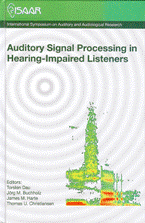Otoacoustic emissions as an indicator of hearing loss
Abstract
Otoacoustic emissions (OAE) are generated as a by-product of the nonlinear cochlear ampli cation process involving the electro-motile properties of the outer hair cells. Most sensorineural hearing losses arise predominantly from reduced cochlear amplification and hence are associated with reduced or absent OAEs. This means that OAE amplitude is a potential indicator of sensorineural hearing loss. However, there is substantial variation in OAE characteristics between individuals with similar hearing threshold, which limits their ability to predict hearing threshold levels (HTL) absolutely. Nonetheless, OAEs are stable within individuals and offer the possibility to predict changes in HTL from changes in OAE amplitude. Prediction of changes in HTL requires knowledge of the relationship between OAE amplitude and HTL as well as the test-retest reliability of OAEs. These parameters were established for a range of transiently evoked and distortion product OAE measures (TEOAE and DPOAE) by testing 43 subjects with HTL across a range from normal hearing to mild hearing loss. Results suggested that TEOAE elicited by a maximum length sequence approach would be most sen- sitive to changes in HTL, having the largest change in amplitude relative to the test-retest reliability. These ideas were further explored by monitoring auditory function in 17 normal hearing subjects over 7 days in whom a reversible hear- ing loss was induced by administering aspirin at maximum therapeutic dose. Further ongoing research is evaluating the potential of TEOAEs for monitor- ing auditory function in people exposed to noise at work. More than 200 new recruits to noisy industry and non-exposed controls have had TEOAEs measured over a 3-year interval to examine whether OAEs are a more sensitive indicator of noise-induced hearing disorder than conventional pure tone audiometry. Preliminary conclusions suggest that OAEs provide a useful physiological correlate of hearing impairment when used in the context of longitudinal monitoring.
References
Beattie, R. C., Kenworthy, O. T. and Luna, C. A. (2003). “Immediate and short term reliability of distortion-product otoacoustic emissions,” Int. J. Audiol., 42, 348-354.
Bonfils, P., Piron, J-P., Uziel, A., and Pujol, R. (1988). “A correlative study of evoked otoacoustic emission properties and audiometric thresholds,” Arch. Otolaryngol., 245, 53-56.
Cazals, Y. (2000). “Auditory sensori-neural alterations induced by salicylate,” Progr. Neurobiol., 62, 583–631.
Engdahl, B., Woxen, O., Arnesen, A.R., and Mair, I.W.S. (1996). “Transient evoked otoacoustic emissions as screening for hearing losses at the school for military training,” Scand. Audiol., 25, 71-78.
Gorga, M. P., Neely, S. T., Bergman, B. M., Beauchaine, K. L., Kaminski, J. R, Peters, J., Schulte, L., and Jesteadt, W. (1993). “A comparison of transient-evoked and distortion product otoacoustic emissions in normal-hearing and hearing-impaired subjects,” J. Acoust. Soc. Am., 94, 2639-2648.
Hall, A. J. (2005). “Otoacoustic Emissions and Hearing Threshold,” PhD Thesis, Uni- versity of Southampton.
Hotz, M. A., Probst, R., Harris, F. R., and Hauser, R. (1993). “Monitoring the effects of noise exposure using transiently evoked otoacoustic emissions,” Acta otolaryngol., 113, 478-482.
Kapadia, S., and Lutman, M.E. (1997). “Are normal thresholds a sufficient condition for click evoked otoacoustic emissions?,” J. Acoust. Soc. Am., 101, 3566-3576.
McFadden, D., and Plattsmier, H.S. (1984). “Aspirin abolishes spontaneous otoacoustic emissions,” J. Acoust. Soc. Am., 76, 443–448.
Marshall, L., and Heller, L.M. (1996). “Reliability of transient-evoked otoacoustic emissions,” Ear Hear., 17, 237-254.
Prieve, B. A., Gorga, M. P., Schmidt, A., Neely, S., Peters, J., Schultes, L. and Jesteadt, W. (1993). “Analysis of transient evoked otoacoustic emissions in normal-hearing and hearing-impaired ears,” J. Acoust. Soc. Am., 93, 3308-3319.
Probst, R, Lonsbury-Martin B.L., and Martin, G.K. (1991). “ A review of otoacoustic emissions,” J. Acoust. Soc. Am., 89, 2027-2067.
Shera, C.A., and Guinan, J.J. (1999). “Evoked otoacoustic emissions arise by two fundamentally different mechanisms: a taxonomy for mammalian OAEs,” J. Acoust. Soc. Am., 105, 782–798.
Sockalingham, R., Key, J., and Ho, C.D. (2007). “Test-retest reliability of distortion- product otoacoustic emissions in children with normal hearing: A preliminary study,” Int. J. Audiol., 46, 351-354.
Thornton, A. R. D. (1993). “High rate otoacoustic emissions,” J. Acoust. Soc. Am., 94, 132-136.
Additional Files
Published
How to Cite
Issue
Section
License
Authors who publish with this journal agree to the following terms:
a. Authors retain copyright* and grant the journal right of first publication with the work simultaneously licensed under a Creative Commons Attribution License that allows others to share the work with an acknowledgement of the work's authorship and initial publication in this journal.
b. Authors are able to enter into separate, additional contractual arrangements for the non-exclusive distribution of the journal's published version of the work (e.g., post it to an institutional repository or publish it in a book), with an acknowledgement of its initial publication in this journal.
c. Authors are permitted and encouraged to post their work online (e.g., in institutional repositories or on their website) prior to and during the submission process, as it can lead to productive exchanges, as well as earlier and greater citation of published work (See The Effect of Open Access).
*From the 2017 issue onward. The Danavox Jubilee Foundation owns the copyright of all articles published in the 1969-2015 issues. However, authors are still allowed to share the work with an acknowledgement of the work's authorship and initial publication in this journal.


